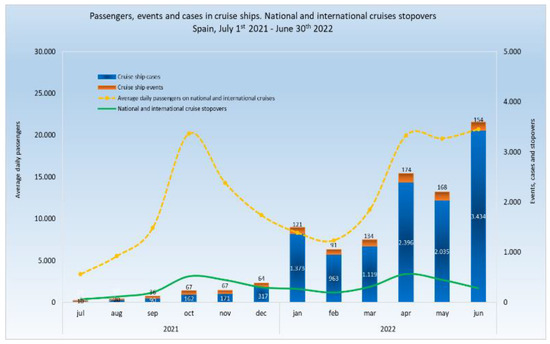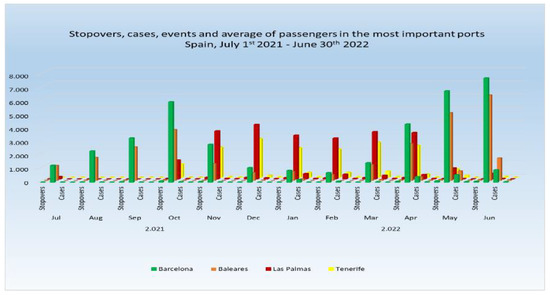Abstract
Spain is a country with an important flow of cruises in Europe. Since the restarting of cruise activity, 1,106 events with 12,134 confirmed cases of COVID-19 were reported from 21 ports. 72.3% of cases and 73.7% of events were registered in the Balearic Islands, Barcelona, Tenerife and Las Palmas, ports with the highest number of layovers and passengers. The events reported increased from October 2021, with a peak in January and April 2022. The cases raised later, in December 2021 with two peaks in January and April and a substantial increase in June 2022. The peak of January coincides with the peak of COVID-19 cases registered in Spain and Europe. The increases in April and June 2022 coincides with the Easter period and the beginning of summer holidays.
1. Introduction
Spain, due to its geographical location, is a country with an important flow of cruises; one of the largest in Europe. In June 2021, due to the improvement of the epidemiological situation, international cruise traffic, was restarted. It had been suspended since March 2020 when the first alarm state was declared due to the start of the pandemic by COVID-19.
Since the restarting of cruise ship operations, cases of COVID-19 have been identified and recorded on board, and reported through the Maritime Declaration of Health (MDH), a management tool that ships must use to communicate health events to the health authorities of each Spanish port of call prior to arrival.
The objective of this study is to describe the evolution of COVID-19 cases on international cruise ships that have made a layover in Spain, registered between July 2021 and June 2022.
2. Material and Methods
A retrospective observational study was carried out using the total confirmed cases of COVID-19 detected on board, reported to the Foreign Health Units (FHU) as port health authorities and communicated by them to the Deputy Directorate of Foreign Health (DDFH).
A confirmed case of COVID-19 was considered to be any passenger or crew member, symptomatic or not, who had a positive diagnostic test for active infection (PCR or antigen).
The sources of information used were, on the one hand, the cases notified by the FHU through the SISAEX tool, compiled and stored in a database prepared and managed by the DDFH of the Ministry of Health, and on the other hand, the data of the layovers and passengers of national and international cruises provided by State Ports Authority.
The data were analysed in a univariate and bivariate way, describing evolution over time.
3. Results
During the study period, 1,106 events were reported with 12,134 confirmed cases of COVID-19, from 21 FHU that cover the same number of ports. In addition, 3,714 layovers and 4,549,773 passengers on national and international cruises were registered in these ports (Figure 1).

Figure 1.
Passengers, events and cases in cruise ships. National and international cruises stopovers.
The monthly median of registered cases was 640 (min 24–max 3434), events 79 (min 10–max 154), layovers 296 (min 64–max 570) and passengers 333,933 (min 104,585–max 621,357). The average number of cases reported per event during the study period was 11 (min 2–max 22).
A total of 72.3% of the cases and 73.7% of the events were registered in four FHU; the Balearic Islands, with 25.3% of cases and 21.1% of events; Barcelona, with 19.8% and 20.3%; Tenerife, with 14.8% and 15.6%; and Las Palmas, with 12.4% and 16.8%, were the most affected ports. These were the ports with the highest number of layovers (Las Palmas 660, Tenerife 626, Barcelona 589 and Balearic Islands 505) and passengers on national and international cruises (Barcelona 1,188,443, Balearic Islands 846,031, Las Palmas 720,933 and Tenerife 497,080), with 71.5% of the total number of passengers and 64.1% of the total layovers in the ports considered in this study.
The evolution of national and international layovers and passengers was variable, with two peaks in October (25.9% of layovers and 17.1% of passengers) and April (34.6% of layovers and 27.4 % of passengers). However, the activity profile was not the same in the main ports; while Barcelona and the Balearic Islands had registered a progressive increase in activity since March, Tenerife and Las Palmas presented more activity between November and April, decreasing thereafter.
A gradual and sustained increase in events was observed, starting in October, with a peak in January of 11% of the total events recorded and another in April of 16%. In the four busiest ports, the evolution of the events was variable. The cases increased later, beginning their ascent in the month of December. Two peaks were observed in January (11%) and April (20%), and a substantial increase in June (28%). The increase in January was observed in the four ports with the highest activity. Tenerife and Las Palmas maintained a high number of cases until April. In Barcelona and the Balearic Islands, the cases fell in February and March and then increased progressively from April (Figure 2).

Figure 2.
Stopover, cases, events and average of passengers in the most important ports.
The number of cases per event was also variable, and gradually increased, especially from January, going from two cases per event on average in July 2021 to 22 in June 2022.
4. Discussion and Conclusions
The arrival of the first international cruise since the restart of activity was in July 2021. From that moment, a gradual increase in reported cases and events has been observed, as well as in the number of cases detected in each event. There has also been an increase in activity in Spanish ports, not so much in the number of layovers, but in the number of passengers, especially from the month of April 2022. The cases have been increasing progressively due, in part, to the increase in cruise activity, but it seems to be more related to the increase in passengers than to the increase in layovers. Likewise, throughout the months of the study, an increase in the cases reported for each event was observed, which may also be related to the increase in the total number of passengers on board.
During the study period, a significant increase in cases was observed in the month of January 2022, coinciding with the peak of COVID-19 cases registered in Spain and Europe. Afterwards, this relationship does not seem to be noticeable. It must be taken into account that, at least in Spain, from January the case notification system changed substantially, according to the National COVID-19 Surveillance and Control Strategy.
After this peak in January, two increases are observed in April and June, coinciding with the Easter period and the beginning of the summer holidays, both times of greater international mobility and tourism.
In the ports with the highest notification of cases and events, which also have a greater activity both in layovers and in passengers, a seasonal variation is observed, greater in the Canary Islands during the winter months and in the Balearic Islands and Barcelona from spring. This last seasonal variation was also observed in other less active ports.
In ports with less activity, less notification of events and cases is observed, which sometimes differs from the number of calls and passengers, being lower than expected according to their activity. This may be due to underreporting by vessels in some cases and by FHU in others, and is the main limitation for data analysis and highlighting the need to improve reporting systems at this level.
Another limitation observed for this study is that both the data on layovers and passengers refer to national and international data, while the numbers of cases and events only refer to international ones.
Author Contributions
Conceptualization, I.M.L. and R.P.S.; methodology, I.M.L., R.P.S., P.L.P. and C.S.F.; software, I.M.L. and R.P.S.; formal analysis, I.M.L. and R.P.S.; investigation, I.M.L. and R.P.S.; writing—original draft preparation, I.M.L. and R.P.S.; writing—review and editing, I.M.L., R.P.S., P.L.P., C.S.F. and L.O.Í.; visualization, R.P.S., L.O.Í., M.D.C., S.B.S., P.L.P., I.V.G., C.S.F., G.G.D., I.W. and F.C.V., supervision, M.D.C. and F.C.V. All authors have read and agreed to the published version of the manuscript.
Funding
This research received no external funding.
Institutional Review Board Statement
The study did not required ethical approval.
Informed Consent Statement
Not applicable. The data used in this study were anonymized.
Data Availability Statement
The data described in this study were extracted from SISAEX tool (Sistema de Sanidad Exterior. Actuaciones Higiénico Sanitarias) database, https://sisaex-ahs.mscbs.gob.es/ahs/acceso/inicio.do (accessed during the whole study period, from 1 July 2021 to 30 June 2022).
Conflicts of Interest
The authors declare no conflict of interest.
Publisher’s Note: MDPI stays neutral with regard to jurisdictional claims in published maps and institutional affiliations. |
© 2022 by the authors. Licensee MDPI, Basel, Switzerland. This article is an open access article distributed under the terms and conditions of the Creative Commons Attribution (CC BY) license (https://creativecommons.org/licenses/by/4.0/).